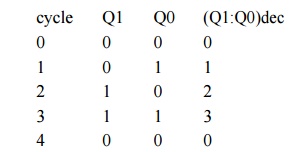Chapter: Digital Logic Circuits : Synchronous Sequential Circuits
Counters and Counters Types
Counters :
In digital logic and computing, a counter is a device which stores (and sometimes displays) the number of times a particular event or process has occurred, often in relationship to a clock signal. In practice, there are two types of counters:
up counters which increase (increment) in value
· down counters which decrease (decrement) in value
Counters Types
In electronics, counters can be implemented quite easily using register-type circuits such as the flip-flop, and a wide variety of designs exist, e.g:
· Asynchronous (ripple) counters
· Synchronous counters
· Johnson counters
· Decade counters
· Up-Down counters
· Ring counters
Each is useful for different applications. Usually, counter circuits are digital in nature, and count in binary, or sometimes binary coded decimal. Many types of counter circuit are available as digital building blocks, for example a number of chips in the 4000 series implement different counters.
Asynchronous (ripple) counters
The simplest counter circuit is a single D-type flip flop, with its D (data) input fed from its own inverted output. This circuit can store one bit, and hence can count from zero to one before it overflows (starts over from 0). This counter will increment once for every clock cycle and takes two clock cycles to overflow, so every cycle it will alternate between a transition from 0 to 1 and a transition from 1 to 0. Notice that this creates a new clock with a 50% duty cycle at exactly half the frequency of the input clock. If this output is then used as the clock signal for a similarly arranged D flip flop (remembering to invert the output to the input), you will get another 1 bit counter that counts half as fast. Putting them together yields a two bit counter:

You can continue to add additional flip flops, always inverting the output to its own input, and using the output from the previous flip flop as the clock signal. The result is called a ripple counter, which can count to 2n-1 where n is the number of bits (flip flop stages) in the counter. Ripple counters suffer from unstable outputs as the overflows "ripple" from stage to stage, but they do find frequent application as dividers for clock signals, where the instantaneous count is unimportant, but the division ratio overall is. (To clarify this, a 1-bit counter is exactly equivalent to a divide by two circuit - the output frequency is exactly half that of the input when fed with a regular train of clock pulses).
Synchronous counters
Where a stable count value is important across several bits, which is the case in most counter systems, synchronous counters are used. These also use flip-flops, either the D-type or the more complex J-K type, but here, each stage is clocked simultaneously by a common clock signal. Logic gates between each stage of the circuit control data flow from stage to stage so that the desired count behavior is realized. Synchronous counters can be designed to count up or down, or both according to a direction input, and may be presetable via a set of parallel "jam" inputs. Most types of hardware-based counter are of this type.
A simple way of implementing the logic for each bit of an ascending counter (which is what is shown in the image to the right) is for each bit to toggle when all of the less significant bits are at a logic high state. For example, bit 1 toggles when bit 0 is logic high; bit 2 toggles when both bit 1 and bit 0 are logic high; bit 3 toggles when bit 2, bit 1 and bit 0 are all high; and so on.
Johnson counters
A Johnson counter is a special case of shift register, where the output from the last stage is inverted and fed back as input to the first stage. A pattern of bits equal in length to the shift register thus circulates indefinitely. These counters are sometimes called "walking ring" counters, and find specialist applications, including those similar to the decade counter, digital to analogue conversion, etc.
Decade counters
Decade counters are a kind of counter that counts in tens rather than having a binary representation. Each output will go high in turn, starting over after ten outputs have occurred. This type of circuit finds applications in multiplexers and demultiplexers, or wherever a scanning type of behaviour is useful. Similar counters with different numbers of outputs are also common.
Up-Down Counters
It is a combination of up counter and down counter, counting in straight binary sequence. There is an up-down selector. If this value is kept high, counter increments binary value and if the value is low, then counter starts decrementing the count. The Down counters are made by using the complemented output to act as the clock for the next flip-flop in the case of Asynchronous counters. An Up counter is constructed by linking the Q out of the J-K Flip flop and putting it into a Negative Edge Triggered Clock input. A Down Counter is constructed by taking the Q output and putting it into a Positive Edge Triggered input
Ring Counters
A ring counter is a counter that counts up and when it reaches the last number that is designed to count up to, it will reset itself back to the first number. For example, a ring counter that is designed using 3 JK Flip Flops will count starting from 001 to 010 to 100 and back to 001. It will repeat itself in a 'Ring' shape and thus the name Ring Counter is given.
Related Topics